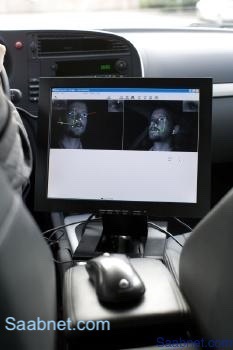

Helping Drivers Keep an Eye on Safety
Trollhattan, Sweden - Saab's Driver Attention Warning System is a development project designed to counter two of the most common causes of road accidents: driver drowsiness and inattention at the wheel. It alerts the driver by using a combination of text and voice messages, or vibrations in the seat cushion, as soon as the risk of drowsiness or inattention is detected.
Unlike other similar systems, the Driver Attention Warning System does not rely on measuring an erratic change in the steered direction of the vehicle. It is designed to detect the onset of drowsiness or inattention, rather than the immediate consequences.
It utilizes two miniature infra-red cameras, one installed at the base of the driver's A-pillar and the other in the center of the main fascia, which are focused on the driver's eyes. The image from the cameras is analyzed by software that deploys a series of alerts when the pattern of eye-lid movement indicates the onset of drowsiness, or when the driver is not looking at the road ahead.
Infra-red imaging is used to ensure good performance in all day and night light conditions, and even if the driver is wearing dark glasses.
Drowsiness Detection
The system uses a sophisticated algorithm, against which the driver's rate of eye blinking is measured. When the cameras detect a pattern of long duration eye-lid closures, indicating the potential onset of drowsiness, a series of three warnings is initiated.
In the first instance, a chime sounds and a text warning message 'Tired?' is displayed in the main instrument panel. If the driver's eye-lid movement does not immediately revert to a normal 'wide awake' pattern, a speech message 'You are tired' is then delivered through the car's audio system. If there is still no response, a stronger warning tone and the message, 'You are dangerously tired ' stop as soon as it is safe to do so!' will come over the audio. This can only be cancelled when the driver presses a reset button in the fascia. The system is then immediately reactivated.
Inattention Detection
The cameras are also able to monitor the driver's eye-ball and head movement. As soon as the driver's gaze moves away from what is defined as the 'primary attention zone' - the central part of the windshield in front of the driver - a timer starts counting.
If the driver's eyes and head do not return to the 'straight ahead' position within about two seconds, the driver's seat cushion will vibrate. This will stop once the position of driver's eyes and head are consistent with the vehicle's direction of travel.
The processing of the infra-red image is sufficiently accurate to detect when the driver retains some peripheral vision of the road ahead - such as while looking in the rear-view mirror, the door mirror or turning a corner - and will consequently allow a slightly longer time to elapse before activating the seat vibration.
Real-life Safety
The Driver Attention Warning System is a logical extension of Saab's real-life safety philosophy. It takes account of what the driver actually does behind the wheel, rather than what he or she should be doing.
The system, installed in a Saab 9-3 SportCombi, is the work of the Human Vehicle Integration team at GME Engineering in Trollhattan, Sweden. It is part of a development program, Intelligent Vehicle Safety Systems (IVSS), supported by the Swedish government and involving the national Road and Transport Research Institute (VTI).
"It is a fact that many drivers do not stop and get out of the car if they are feeling drowsy. So we are now trying to help drivers to help themselves,' says Arne Nabo, head of the Human Vehicle Integration team, which specializes in driver ergonomics and managing the interface with in-car 'infotainment' systems for Saab cars.
"This system also helps prevent a dangerous habit we call 'cognitive capturing'. For example, the driver can become too absorbed in searching for a favorite CD, programming pre-sets into the radio or trying pick up a screaming baby's dummy from the floor."
Testing
The Saab 9-3 Sport Combi development car will now participate in an eight-month field trial program supervised by the Road and Transport Research Institute.
The car is fitted with a wireless GPRS 3G modem that will download data every minute to a web server at Linkoping University, where the performance of the system will be analyzed. A group of volunteers will each drive the car for a month, the first week with the Driver Attention Warning System switched off for comparison purposes
The trial is part of a development and validation process that could see the system become available in future Saab cars. In commercial production, only a single camera is likely to be required and this would be completely concealed behind the car's main fascia.
 |
 |
 |
 |
 |
